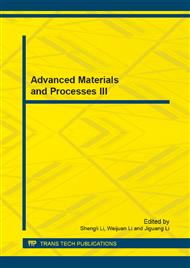p.289
p.293
p.297
p.302
p.308
p.313
p.318
p.323
p.327
Research on the Optimization of Heat Treatment Process and the Abrasive Impact Wear Mechanism of 70Mn Steel
Abstract:
This research was conducted on the influence of heat treatment parameters on the mechanical properties and abrasive wear resistance of 70Mn steel through experimental results. Orthogonal experiment was applied for designing heat treatment process and acquired optimal heat treatment parameters. The experimental results showed that the optimum heat treatment process was firstly heated to 830°C preserved for 60min, and rapidly quenched, then tempered at 200°C for 80min. Abrasive impact wear experiment was performed on MLD-10 tester, under which the wear surface and the subsurface were observed through scanning electron microscope and optical microscope. According to the experimental result, abrasive impact wear mechanism was analyzed. The results showed that plastic deformation fatigue and gouging wear were the primary mechanisms of abrasive impact wear, together with a small amount of furrow and cutting.
Info:
Periodical:
Pages:
308-312
Citation:
Online since:
September 2013
Authors:
Price:
Сopyright:
© 2013 Trans Tech Publications Ltd. All Rights Reserved
Share:
Citation:


